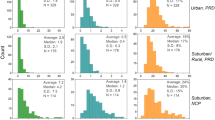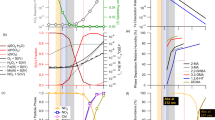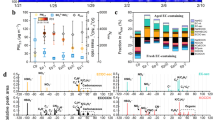Abstract
Particle acidity affects aerosol concentrations, chemical composition and toxicity. Sulfate is often the main acid component of aerosols, and largely determines the acidity of fine particles under 2.5 μm in diameter, PM2.5. Over the past 15 years, atmospheric sulfate concentrations in the southeastern United States have decreased by 70%, whereas ammonia concentrations have been steady. Similar trends are occurring in many regions globally. Aerosol ammonium nitrate concentrations were assumed to increase to compensate for decreasing sulfate, which would result from increasing neutrality. Here we use observed gas and aerosol composition, humidity, and temperature data collected at a rural southeastern US site in June and July 2013 (ref. 1), and a thermodynamic model that predicts pH and the gas–particle equilibrium concentrations of inorganic species from the observations to show that PM2.5 at the site is acidic. pH buffering by partitioning of ammonia between the gas and particle phases produced a relatively constant particle pH of 0–2 throughout the 15 years of decreasing atmospheric sulfate concentrations, and little change in particle ammonium nitrate concentrations. We conclude that the reductions in aerosol acidity widely anticipated from sulfur reductions, and expected acidity-related health and climate benefits, are unlikely to occur until atmospheric sulfate concentrations reach near pre-anthropogenic levels.
This is a preview of subscription content, access via your institution
Access options
Subscribe to this journal
Receive 12 print issues and online access
$259.00 per year
only $21.58 per issue
Buy this article
- Purchase on Springer Link
- Instant access to full article PDF
Prices may be subject to local taxes which are calculated during checkout



Similar content being viewed by others
References
Guo, H. et al. Predicting particle water and pH in the southeastern United States. Atmos. Chem. Phys. 15, 5211–5228 (2015).
Hand, J. L., Schichtel, B. A., Malm, W. C. & Pitchford, M. L. Particulate sulfate ion concentration and SO2 emission trends in the United States from the early 1990s through 2010. Atmos. Chem. Phys. 12, 10353–10365 (2012).
Pinder, R. W., Gilliland, A. B. & Dennis, R. L. Environmental impact of atmospheric NH3 emissions under present and future conditions in the eastern United States. Geophys. Res. Lett. 35, L12808 (2008).
Pinder, R. W., Adams, P. J. & Pandis, S. N. Ammonia emission controls as a cost-effective strategy for reducing atmospheric particulate matter in the eastern United States. Environ. Sci. Technol. 41, 380–386 (2007).
Heald, C. L. et al. Atmospheric ammonia and particulate inorganic nitrogen over the United States. Atmos. Chem. Phys. 12, 10295–10312 (2012).
Tsimpidi, A. P., Karydis, V. A. & Pandis, S. N. Response of inorganic fine particlulate matter to emission changes of sulfur dioxide and ammonia: the eastern United States as a case study. J. Air Waste Manage. Assoc. 57, 1489–1498 (2007).
West, J. J., Ansari, A. S. & Pandis, S. N. Marginal PM2.5: nonlinear aerosol mass response to sulfate reductions in the eastern United States. J. Air Waste Manage. Assoc. 49, 1415–1424 (1999).
Saylor, R., Myles, L., Sibble, D., Caldwell, J. & Xing, J. Recent trends in gas-phase ammonia and PM2.5 ammonium in the southeast United States. J. Air Waste Manage. Assoc. 65, 347–357 (2015).
Lelieveld, J., Evans, J. S., Fnais, M., Giannadaki, D. & Pozzer, A. The contribution of outdoor air pollution sources to premature mortality on a global scale. Nature 525, 367–371 (2015).
Bellouin, N. et al. Aerosol forcing in the Climate Model Intercomparison Project (CMIP5) simulations by HadGEM2-ES and the role of ammonium nitrate. J. Geophys. Res. 116, D20206 (2011).
Xu, L. et al. Effects of anthropogenic emissions on aerosol formation from isoprene and monoterpenes in the southeastern United States: insights from SOAS and beyond. Proc. Natl Acad. Sci. USA 112, 37–42 (2015).
Meskhidze, N., Chameides, W. L., Nenes, A. & Chen, G. Iron mobilization in mineral dust: can anthropogenic SO2 emissions affect ocean productivity? Geophys. Res. Lett. 30, 2085 (2003).
Ghio, A. J., Carraway, M. S. & Madden, M. C. Composition of air pollution particles and oxidative stress in cells, tissues, and living systems. J. Toxicol. Environ. Health B 15, 1–21 (2012).
Thurston, G. D., Ito, K., Hayes, C. G., Bates, D. V. & Lippman, M. Respiratory hospital admissions and summertime haze air pollution in Toronto, Ontario: consideration of the role of acid aerosols. Environ. Res. 65, 271–290 (1994).
Raizenne, M. et al. Health effects of acid aerosol on North American children: pulmonary function. Environ. Health Perspect. 104, 506–514 (1996).
Hidy, G. M. et al. Chemical climatology of the southeastern United States, 1999–2013. Atmos. Chem. Phys. 14, 11893–11914 (2014).
You, Y. et al. Atmospheric amines and ammonia measured with a Chemical Ionization Mass Spectrometer (CIMS). Atmos. Chem. Phys. 14, 12181–12194 (2014).
Xing, J. et al. Historical gaseous and primary aerosol emissions in the United States from 1990 to 2010. Atmos. Chem. Phys. 13, 7531–7549 (2013).
Heintzenberg, J. Fine particles in the global troposphere, a review. Tellus 41B, 149–160 (1989).
Kim, P. S. et al. Sources, seasonality, and trends of southeast US aerosol: an integrated analysis of surface, aircraft, and satellite observations with the GEOS-Chem chemical transport model. Atmos. Chem. Phys. 15, 10411–10433 (2015).
Hand, J. L., Schichtel, B. A., Pitchford, M., Malm, W. C. & Frank, N. H. Seasonal composition of remote and urban fine particulate matter in the United States. J. Geophys. Res. 117, D05209 (2012).
Hennigan, C. J., Izumi, J., Sullivan, A. P., Weber, R. J. & Nenes, A. A critical evaluation of proxy methods used to estimate the acidity of atmospheric particles. Atmos. Chem. Phys. 15, 1–15 (2015).
Fountoukis, C. & Nenes, A. ISORROPIA II: a computationally efficient thermodynamic equilibrium model for K+–Ca2+–Mg2+–NH4+–Na+–SO42−–NO3−–Cl−–H2O aerosols. Atmos. Chem. Phys. 7, 4639–4659 (2007).
Nenes, A., Pandis, S. N. & Pilinis, C. ISORROPIA: a new thermodynamic equilibrium model for multiphase multicomponent inorganic aerosols. Aquat. Geochem. 4, 123–152 (1998).
Stumm, W. & Morgan, J. J. Aquatic Chemistry: Chemical Equilibria and Rates in Natural Waters (Wiley, 1996).
Cerully, K. et al. On the link between hygroscopicity, volatility and aerosol oxidation state of ambient and water-soluble aerosol in the southeastern United States. Atmos. Chem. Phys. 15, 8679–8694 (2015).
You, Y., Renbaum-Wolff, L. & Bertram, A. K. Liquid–liquid phase separations in particles containing organics mixed with ammonium sulfate, ammonium bisulfate, ammonium nitrate or sodium chloride. Atmos. Chem. Phys. 13, 11723–11734 (2013).
Zhang, J. et al. Validity of thermodynamic equilibrium assumption for fine particulate composition: nitrate and ammonium during Atlanta ’99 Supersite Experiment. J. Geophys. Res. 108, 8414 (2003).
Fountoukis, C. et al. Thermodynamic characterization of Mexico City Aerosol during MILAGRO 2006. Atmos. Chem. Phys. 9, 2141–2156 (2009).
Duyzer, J. Dry deposition of ammonia and ammonium aerosols over heathland. J. Geophys. Res. 99, 18757–18763 (1994).
Schrader, F. & Brummer, C. Land use specific ammonia deposition velocities: a reveiw of recent studies (2004–2013). Wat. Air Soil Pollut. 225, 2114–2126 (2014).
Acknowledgements
This research was supported by a grant from the National Science Foundation through contract number 1242258, US Environmental Protection Agency Grants RD835410 and RD834799. Its contents are solely the responsibility of the grantee and do not necessarily represent the official views of the US government. Further, the US government does not endorse the purchase of any commercial products or services mentioned in the publication. Atmospheric Research Associates (ARA) and the SOAS team provided observational data and logistical support.
Author information
Authors and Affiliations
Contributions
R.J.W. initiated the investigation. H.G. and A.N. performed the thermodynamic modelling analyses. A.G.R. provided the mass balance analysis. All authors extensively discussed the concepts, commented on the manuscript and contributed to writing the manuscript.
Corresponding author
Ethics declarations
Competing interests
The authors declare no competing financial interests.
Supplementary information
Supplementary Information
Supplementary Information (PDF 578 kb)
Rights and permissions
About this article
Cite this article
Weber, R., Guo, H., Russell, A. et al. High aerosol acidity despite declining atmospheric sulfate concentrations over the past 15 years. Nature Geosci 9, 282–285 (2016). https://doi.org/10.1038/ngeo2665
Received:
Accepted:
Published:
Issue Date:
DOI: https://doi.org/10.1038/ngeo2665
This article is cited by
-
Thermodynamical framework for effective mitigation of high aerosol loading in the Indo-Gangetic Plain during winter
Scientific Reports (2023)
-
Unanswered questions on the airborne transmission of COVID-19
Environmental Chemistry Letters (2023)
-
Dust emission reduction enhanced gas-to-particle conversion of ammonia in the North China Plain
Nature Communications (2022)
-
Significant contributions of combustion-related sources to ammonia emissions
Nature Communications (2022)
-
Vegetation-related dry deposition of global PM2.5 from satellite observations
Journal of Geographical Sciences (2022)



